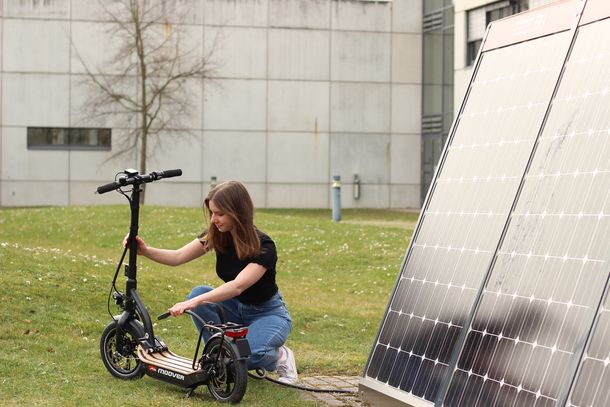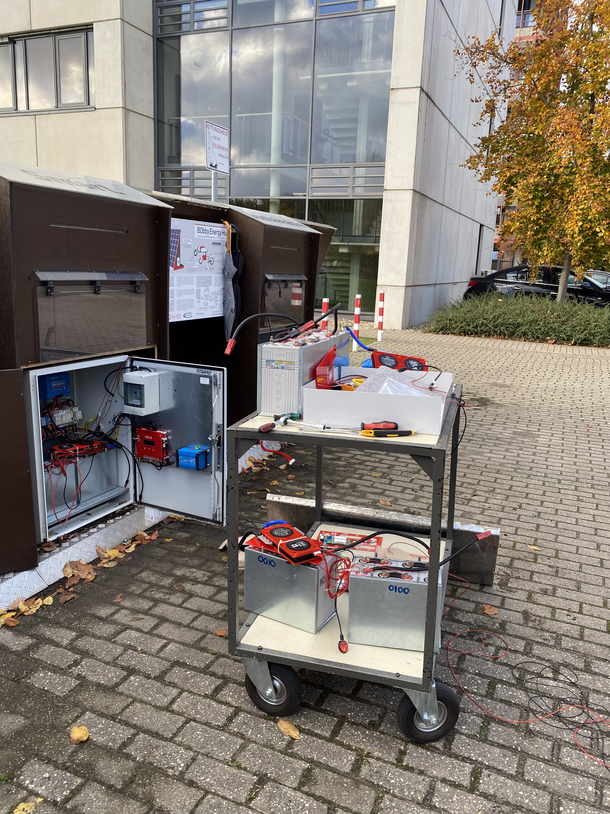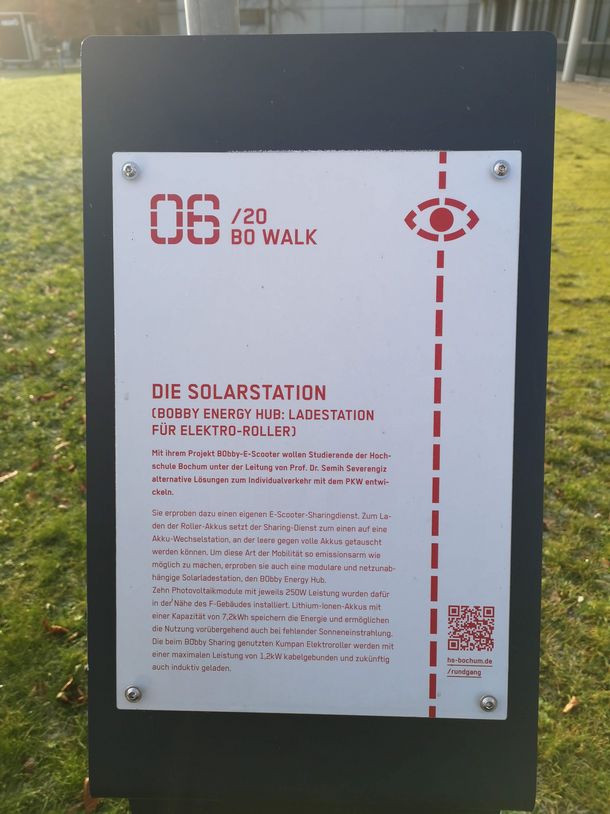Project study "Sustainable mobility in the district"
In the winter semester 2020/21 and summer semester 2021, students led by Prof Dr Iris Mühlenbruch and Prof Dr Semih Severengiz carried out the project study "Sustainable mobility in the district". This involved researching concepts with sustainable mobility innovations for the residential district "Kortland-Viertel" and the commercial district "Bergmannsheil" in Bochum. As part of the project study, a mobility survey of the employees of the BG University Hospital Bergmannsheil was conducted with 379 participants. You can read the results of the study here (only available in German):
Update of the EnergyHub - More data for research and teaching
The EnergyHub is an off-grid photovoltaic charging station for Light Electric Vehicles (LEVs). This off-grid charging station can be used to charge batteries of e-mopeds, e-scooters, e-bikes and e-cargobikes with renewable electricity. The Energy Hub is operated both as a teaching object and for research in a real laboratory in the Smart City Urban Mobility (SCiSusMob) 1 and SciSusMob 2 projects funded by the German Federal Ministry of Education and Research (BMBF) to obtain data and findings. Furthermore, the EnergyHub is an important component of the BObby Sharing project study, as it enables autonomous renewable energy generation at the Bochum University of Applied Sciences campus as well as charging of the electrified vehicles involved in the project. In line with our goal of continuous improvement of research and teaching, we are currently working on extracting even more potential from the station.
The EnergyHub was installed in September 2020 and consists of ten photovoltaic modules and three charging cabinets. The photovoltaic modules used originally come from industry, where they were discarded due to declining performance. However, these modules are often still in very good usable condition. After being tested by an external company, they are used again at our EnergyHub and, with an output of 250 watts each, have enough power to charge our Light Electric Vehicles. This gives the EnergyHub a total output of 2,500 watts. By recycling already used photovoltaic modules the service life of the photovoltaic modules is extended, resulting in lower energy and material consumption and increased resource efficiency. More information on the life cycle assessment (LCA) can be found here. The three charging cabinets have a total battery capacity of 7.2 kilowatts and each cabinet is equipped with two batteries, a solar charger, a power inverter and a control unit. On clear days in summer, the batteries are fully charged within a day. In practice, this means with the available battery capacity, we can fully charge three e-mopeds with 2 batteries each. A fully charged e-moped can reach a distance of 80 kilometers on average. However, exact distances always depend on the vehicle and battery type as well as the temperature. The capacity of a battery decreases if the temperature is too cold or too hot: the optimum operating temperatures for lithium-ion batteries are thus approximately those at the temperatures at which we humans feel comfortable, in other words around 20 degrees Celsius. For this reason, BObby Sharing, as well as other providers, stops operating as soon as temperatures drop below 4 degrees Celsius, in order to preserve the batteries. The photovoltaic modules, on the other hand, can be operated all year round and still function in cold temperatures as long as there is enough sunlight. Charging the e-mopeds, e-scooters, e-bikes or e-cargobikes works very simply: Drive to the station, open the cabinet by access card and plug in - the LEV is charging and you can come back later to continue driving with the charged vehicle. It is optimal for the batteries if the charging is done before the battery drops below 20 percent, because the life of a lithium-ion battery is longer if a charge is always between about 20 and 80 percent, although falling below 20 percent is more serious.
Reconstruction of the EnergyHub
To enable the EnergyHub to be used even more efficiently, conversions and extensions are currently being carried out. One innovation concerns the control unit installed in the charging cabinets, which was previously operated by an external company and only allowed limited data to be recorded and evaluated. On the one hand, it was limited to viewing data from individual cabinets, and on the other hand, some data, such as the battery voltage and amperage of the solar charger, was not recorded at all. For further research and optimization of the photovoltaic modules and the charging cabinets, a self-controlled unit was installed in order to be able to store the received data on a own server. In this way it is possible to control and request the required data and to create comprehensive evaluations in the form of dashboards, which in turn can be used in teaching and research. Live transmission is also made possible, which sends out messages when problems occur so that they can be quickly resolved. This allows us to improve the service life and quality of the individual parts.
Another central aspect of the in-house data collection and evaluation is the efficient use of load management, which actively controls electricity consumption. By means of load management, it is possible, for example, to control when electricity may be released for charging and when not. This makes it possible to ensure greater safety and a long battery life. Specific examples include automatically cutting off power when a battery is fully charged or not allowing charging when the outside temperature is too hot or too cold for safe use. The collection of data, in addition to the benefits explained for current use, also forms the foundation for future research. The long-term goal of in-house data collection is to be predictive with the available battery and charging capacity. This means that external factors such as the weather forecast or the days of the week should be included in the control process. This includes operating with optimal charging capacity between 20 and 80 percent, which also applies to the batteries in the EnergyHub that store solar energy. Apart from that, the basic functions of the charging cabinet also require power, which is why the battery should not run down too much. This means that every time a vehicle is to be charged, the charging cabinet must decide whether there is still enough power available. To make an informed and predictive decision, the control unit could now make use of data from the weather report and calendar and make a multi-criteria-based decision according to previously entered decision patterns.
One example: If an LEV needs to be recharged on a Friday evening, but there is only 30 percent battery capacity left in the EnergyHub, the system can now look at whether there is plenty of sunshine on Saturday for recharging. If so, the system can release power for recharging despite low charge levels because the system has also been told that there will be less activity at the university on Saturday and therefore less demand for recharging. Other conceivable scenarios and decision criteria include how far away the other LEVs are and the likelihood that more LEVs will be charged. Basically, there are no limits to the scenarios and possible decision criteria. By installing the own control unit, internal data, such as the State of Charge or the energy flow, external data via an API interface, such as the above-mentioned weather report and calendar data, or also usage data, usage forecasts and data on the system status can be retrieved, compiled and evaluated in the future.
At the same time as the new control units are being installed, the charging cabinets are being upgraded. Previously, access to the inside of the charging cabinets was only possible through a screwed-down panel, which made maintenance in particular very inconvenient. For this reason, each loading cabinet will now be fitted with a door including a safety lock. The installation of the doors makes access to the control unit, the batteries, the solar charger and the power inverter much more convenient for those with access rights. Maintenance and repairs can be carried out more easily and quickly, and the construction of the charging cabinets is safer and more durable.
Future Outlook
Besides the current development at the EnergyHub, further projects for the future are to come. The photovoltaic systems and the charging cabinets are already part of the BO Walk, act as a teaching object for sustainability and also provide further information on the BObby Sharing project study. To make the experience even more vivid and attractive, we plan to install an interactive tablet in the future to provide information to visitors. For this purpose, dashboards of current data from the control unit will also be made available. Possible information can include the current status of the systems or how much charge is possible in the next 24 hours in the current weather. The dashboard will be interactive and available on the tablet as well as on the BObby Sharing website. Another project is to add new forms of charging. Up to now, charging at the EnergyHub has been cable-based, but we are also planning to add inductive - meaning wireless - charging options.
Have we sparked your interest and you would like to work at EnergyHub? We are always looking for new and motivated students! You can support us in different ways, be it as part of a project study, your practical phase, an internship or for your bachelor or master thesis.
Contact:
Jaron Schünemann (Project Management BObby Sharing, SCiSusMob 2)
E-mail: jaron.schuenemann[at]hs-bochum.de
Room: D3-04
Kontakt
Jaron Schünemann (Projektleitung BObby Sharing, SCiSusMob 2)
E-Mail: jaron.schuenemann[at]hs-bochum.de
Raum: D3-04




